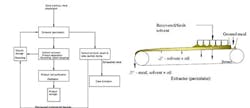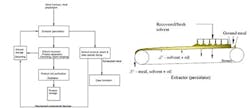Prevent Vapor Vent Vexations
This Month’s Puzzler
We use a variety of solvents at our pharmaceutical plant. Until recently, we largely ignored the vent system feeding our thermal oxidizer (TOX). Although the decanting and distillation tower for separating solvents works flawlessly, the TOX system sometimes acts up; the environmental regulators forced us to install a backup system. Lately, the vent system drew our attention when vapor detectors caused a trip during new solvent unloading. Then, everything went haywire. I was sent by corporate to investigate.
The operator claims the suction is very bad and truck drivers complain about the fumes. I found out that, to avoid the fumes, the drivers hook up and walk away and the operator watches from the control station. Plant engineering gripes that a series of expansion projects connected to the system without addressing underlying problems. With budget cuts, corporate says there isn’t any money. One engineer grumbled that the vent alarm is faulty; he says the over-loaded distributed control system suffers from a power supply problem that causes alarm trips.
As I expected, the utility piping and instrumentation diagrams are a joke. The line sizes are missing and many vent connections either don’t appear or go to unused tanks. I found a show-stopper: a tank with a blind flange removed from a vent nozzle. Maintenance is pretty sure the slide gate is closed on the abandoned tank and says not to worry about it. I drew up a quick flow diagram to begin my investigation (see: https://bit.ly/3bcKQ5j).
A walkdown of the system showed corrosion and water vapor at some of the flanges, duct joints and two blowers, (F-55 and F-400, the main blower). The other blower (F-65) looks clean because the tank hardly ever is emptied. Maintenance says the corrosion is normal.
Where should I start? What should I do about the abandoned tank?
Review Multiple Issues
Consider eight key points:
1. A gas-detector trip, if not spurious, represents a major safety concern, so you should address this first:
• Review logbooks, data historians or trends to determine events that could have caused an alarm trip.
• Talk to operators who were on shift when the trip occurred; they might offer valuable insights.
• Survey the area to ensure gas leaks are not recurring.
2. On the other hand, if spurious signals caused the trip, then consider checking calibration (with appropriate gas samples). Point gas detectors based on infrared could suffer from interference. Similarly, dirt or trash could affect catalyst bed detectors. Although the selection and design phase of area gas detectors generally considers issues such as spurious signals, lack of signals (dangerous failure), calibration, installation and maintenance, recheck. Contact the gas detector supplier to discuss these issues. Recent models of gas detectors with auto-diagnostics provide a safer and reliable setup.
3. The driver complaining about and staying away from fumes during loading/unloading of solvent is, in effect, pointing to a potential fire hazard. What is the odor threshold of the solvent and how does that compare with the lower flammability limit (LFL) of the solvent? If the odor threshold is substantially below the LFL (say, half the LFL), then it becomes an exposure issue involving a check on the PEL (permissible exposure level (PEL) and short-term exposure level (STEL) values of the solvent. Refer to the supplier’s safety data sheet for the solvent, OSHA 29 CFR 1910.1000 (Z-tables) or contact the vendor.
4. The TOX sometimes “acting up” may relate to, among other causes, temporary high flow from one or more of the storage vessels (e.g., ethanol, acetone and others) or liquid carry-over. Check and ensure the condensate trap is not plugged. It also is interesting to note that there is no trap on the ethyl acetate, solvent loading/unloading and waste solvent storage. Verify that entrainment is not possible and the temperature (in the line) does not fall below the dew point of any of the vapors.
5. Check scenarios that were used in sizing the TOX. Do not focus solely on average or normal flow rates. Carefully think about scenarios that could contribute to temporary spikes that could exceed TOX capacity and, hence, could cause environmental infractions. Consider assembling a small group of people (say, operators and engineers) familiar with day-to-day operation of the vent system and TOX to do a mini-HAZOP of the system.
6. Excessively long lines to the compressor (blower) could cause vacuum in the suction line and a possibility of air ingress, which, in turn could create flammable mixture in the suction line.
• Ensure all flange connections are sufficiently tight.
• Verify adequate pipe support to minimize adverse effects of vibration.
• Check suction pressure at the compressors (F55, F65). Many compressors in flammable gas service include a vacuum sensor and, in case of deep vacuum, an interlock (that shuts down the compressor and purges the line with an inert gas).
• Calculate pressure drops in gas flows and ensure the possibility of forming vacuum is minimized.
7. Corporate financial limitations pose a challenge. Safety infrastructure, as alluded to in the problem statement, is way below par. Consider making a business case for safety investment. Submit cost/benefit and return-on-investment-related information to the financial professional at Corporate. Make a prioritized listing for the crucial upgrades required at the plant. Emphasize the need for quick action.
8. In the very long run, consider changing the company “safety culture.” Be patient — it will not happen right away.
GC Shah, consultant
Houston
Inattention Incurs A Cost
Utilities nearly always are in a state of near-collapse and only get some of the attention they deserve after causing a major headache or outage. Guess what?! You’re there.
Alarms trip for a reason: tramp air. Symptoms: corrosion at the outside of sealed joints. This is a cheap fix — so, start here. Clean the joints and then tape and caulk them. Inspect all vent valves and blinds sealing those of unused tanks. The only exception to unused tanks is if they contain volatile organic compounds and weren’t cleaned properly.
The un-isolated acid system acts as a dye in this case; even with a blind, fumes get in.
Another issue you can chase down without much money is identifying incompatibility in chemicals that are combined in your vent system. Research is cheap but often very productive.
Lastly, do a compressible fluid network study to see how the fans are loaded. I’ve written several spreadsheets assuming simplified corresponding-state vapor models. Balancing the equations can be a little hairy but a spreadsheet is a lot cheaper than a simulation package. It’s a step up from the old hand calculator days.
Dirk Willard, consultant
Wooster, Ohio
Figure 1. Processor aims to use upcoming expansion to make process improvements — but which ones?
May’s Puzzler
I run a mill (Figure 1) that processes different types of oil seeds, e.g., soybeans, into oils that our clients then sell. After five years of operation, we want to expand capacity and improve quality. This also will provide an opportunity to deal with some lingering problems in the process; the grinding part of the plant and the cleaning system is designed well but the owners seemingly ran out of money when it came to the solvent extraction set-up. The word has gotten out that we are looking for improvements to consider — and everyone has an idea. I need help sorting through these suggestions.
One of the owners says we should consider an enzyme addition to the hexane we use; during construction, he had pushed for going with an exotic solvent instead of tried-and-true hexane; at his behest, the salesperson continues to badger me.
Our young maintenance engineer has a fairly lengthy list: 1) cartridge filters to take care of fouling in the solvent recycle system (I reckon socks would work better); 2) a weir instead of spray nozzles that clog (but a weir can plug); 3) stronger vacuum on the percolator screen and in the meal dryer (which seems sensible until you consider flammability with hexane); 4) fouling in the steam deaerator tank (he blames the chemical treatment — but that needs more study); 5) decanter fouling in the solvent recovery prior to steam stripping; and 6) tearing of the percolator screen every month — he found a screen maker that invented an easier unzipping of the screen, which is a really good idea!
Our quality control manager’s agenda is to improve the clarity in the oil. I’m still waiting for his shopping list.
What do you think is the best approach for us to improve the plant performance?
Send us your comments, suggestions or solutions for this question by April 9, 2021. We’ll include as many of them as possible in the May 2021 issue and all on ChemicalProcessing.com. Send visuals — a sketch is fine. E-mail us at [email protected] or mail to Process Puzzler, Chemical Processing, 1501 E. Woodfield Rd., Suite 400N, Schaumburg, IL 60173. Fax: (630) 467-1120. Please include your name, title, location and company affiliation in the response.
And, of course, if you have a process problem you’d like to pose to our readers, send it along and we’ll be pleased to consider it for publication.

